The Synthesis and Property Study of NH-Ac-Anchored Multilayer 3D Polymers
Abstract
1. Introduction
2. Results
3. Materials and Methods
4. Conclusions
Supplementary Materials
Author Contributions
Funding
Institutional Review Board Statement
Informed Consent Statement
Data Availability Statement
Acknowledgments
Conflicts of Interest
References
- Skotheim, T.A.; Elsenbaumer, R.L.; Reynolds, J.R. (Eds.) Handbook of Conducting Polymers, 2nd ed.; CRC Press: Boca Raton, FL, USA, 1997; ISBN 9780824700508. [Google Scholar]
- Hill, D.J.; Mio, M.J.; Prince, R.B.; Hughes, T.S.; Moore, J.S. A Field Guide to Foldamers. Chem. Rev. 2001, 101, 3893–4012. [Google Scholar] [CrossRef] [PubMed]
- Crawford, R.J.; Martin, P.J. Plastics Engineering; Butterworth-Heinemann: Oxford, UK, 2020. [Google Scholar]
- Liou, G.-S.; Chen, W.-C.; Kakuchi, T. Current progress in advanced polymer materials for electronics/photonics functions. React. Funct. Polym. 2016, 108, 1. [Google Scholar] [CrossRef]
- Pugliese, R.; Beltrami, B.; Regondi, S.; Lunetta, C. Polymeric Biomaterials for 3D Printing in Medicine: An Overview. Ann. 3D Print. Med. 2021, 2, 100011. [Google Scholar] [CrossRef]
- de Leon, A.C.; Chen, Q.; Palaganas, N.B.; Palaganas, J.O.; Manapat, J.; Advincula, R.C. High Performance Polymer Nanocomposites for Additive Manufacturing Applications. React. Funct. Polym. 2016, 103, 141–155. [Google Scholar] [CrossRef]
- Wang, J.-Y.; Tang, Y.; Wu, G.-Z.; Zhang, S.; Rouh, H.; Jin, S.; Xu, T.; Wang, Y.; Unruh, D.; Surowiec, K.; et al. Asymmetric Catalytic Assembly of Triple-columned and Multilayered Chiral Folding Polymers Showing Aggregation-induced Emission (AIE). Chem. Eur. J. 2022, 28, e202104102. [Google Scholar] [CrossRef]
- Takale, B.S.; Thakore, R.R.; Irvine, N.M.; Schuitman, A.D.; Li, X.; Lipshutz, B.H. Sustainable and cost-effective Suzuki–Miyaura couplings toward the key biaryl subunits of Arylex and Rinskor active. Org. Lett. 2020, 22, 4823–4827. [Google Scholar] [CrossRef]
- Patil, R.C.; Dongare, P.R.; Patil, S.S. Aqueous extract of CAP-ash: A greener benchmark for Suzuki-Miyaura coupling reaction in palladium catalyzed ligand-free condition. J. Mol. Struct. 2025, 1321, 140160. [Google Scholar] [CrossRef]
- Tang, Y.; Zhang, S.; Xu, T.; Yuan, Q.; Wang, J.-Y.; Jin, S.; Wang, Y.; Pan, J.; Griffin, I.; Chen, D.; et al. Aggregation-Induced Polarization (AIP): Optical Rotation Amplification and Adjustment of Chiral Aggregates of Folding Oligomers and Polymers. Front. Chem. 2022, 10, 962638. [Google Scholar] [CrossRef]
- Wu, G.; Liu, Y.; Yang, Z.; Ma, L.; Tang, Y.; Zhao, X.; Rouh, H.; Zheng, Q.; Zhou, P.; Wang, J.-Y.; et al. Triple-Columned and Multiple-Layered 3D Polymers: Design, Synthesis, Aggregation-Induced Emission (AIE), and Computational Study. Research 2021, 2021, 3565791. [Google Scholar] [CrossRef]
- Tang, Y.; Jin, S.; Zhang, S.; Wu, G.-Z.; Wang, J.-Y.; Xu, T.; Wang, Y.; Unruh, D.; Surowiec, K.; Ma, Y.; et al. Multilayer 3D Chiral Folding Polymers and Their Asymmetric Catalytic Assembly. Research 2022, 2022, 9847949. [Google Scholar] [CrossRef]
- Zhang, Y.-X.; Wang, L.-Y.; Dai, J.-K.; Liu, F.; Li, Y.-T.; Wu, Z.-Y.; Yan, C.-W. The Comparative Study of Cocrystal/Salt in Simultaneously Improving Solubility and Permeability of Acetazolamide. J. Mol. Struct. 2019, 1184, 225–232. [Google Scholar] [CrossRef]
- Budziak, I.; Arczewska, M.; Kamiński, D.M. Formation of Prenylated Chalcone Xanthohumol Cocrystals: Single Crystal X-Ray Diffraction, Vibrational Spectroscopic Study Coupled with Multivariate Analysis. Molecules 2019, 24, 4245. [Google Scholar] [CrossRef] [PubMed]
- Chkirate, K.; Karrouchi, K.; Chakchak, H.; Mague, J.T.; Radi, S.; Adarsh, N.N.; Li, W.; Talbaoui, A.; Essassi, E.M.; Garcia, Y. Coordination Complexes Constructed from Pyrazole–Acetamide and Pyrazole–Quinoxaline: Effect of Hydrogen Bonding on the Self-Assembly Process and Antibacterial Activity. RSC Adv. 2022, 12, 5324–5339. [Google Scholar] [CrossRef] [PubMed]
- Balijapalli, U.; Udayadasan, S.; Panyam Muralidharan, V.; Sukumarapillai, D.K.; Shanmugam, E.; Gopal, A.P.; Rathore, R.S.; Iyer, S.K. An Insight into the Photophysical Properties of Amide Hydrogen Bonded N-(Benzo[d]Thiazol-2-Yl) Acetamide Crystals. Spectrochim. Acta A Mol. Biomol. Spectrosc. 2017, 173, 572–577. [Google Scholar] [CrossRef] [PubMed]
- Tang, C.; Li, X.; Li, Z.; Hao, J. Interfacial Hydrogen Bonds and Their Influence Mechanism on Increasing the Thermal Stability of Nano-SiO2-Modified Meta-Aramid Fibres. Polymers 2017, 9, 504. [Google Scholar] [CrossRef]
- Rakipov, I.T.; Sabirzyanov, A.N.; Petrov, A.A.; Akhmadiayrov, A.A.; Varfolomeev, M.A.; Solomonov, B.N. Thermochemistry of Hydrogen Bonding of Linear and Cyclic Amides in Proton Acceptors Media. Thermochim. Acta 2017, 652, 34–38. [Google Scholar] [CrossRef]
- Fornaro, T.; Burini, D.; Biczysko, M.; Barone, V. Hydrogen-Bonding Effects on Infrared Spectra from Anharmonic Computations: Uracil–Water Complexes and Uracil Dimers. J. Phys. Chem. A 2015, 119, 4224–4236. [Google Scholar] [CrossRef]
- Giubertoni, G.; Hilbers, M.; Caporaletti, F.; Laity, P.; Groen, H.; Van der Weide, A.; Bonn, D.; Woutersen, S. Hydrogen Bonds under Stress: Strain-Induced Structural Changes in Polyurethane Revealed by Rheological Two-Dimensional Infrared Spectroscopy. J. Phys. Chem. Lett. 2023, 14, 940–946. [Google Scholar] [CrossRef]
- Cao, Y.; Zhou, P.; Tu, Y.; Liu, Z.; Dong, B.-W.; Azad, A.; Ma, D.; Wang, D.; Zhang, X.; Yang, Y.; et al. Modification of TiO2 Nanoparticles with Organodiboron Molecules Inducing Stable Surface Ti3+ Complex. iScience 2019, 20, 195–204. [Google Scholar] [CrossRef]
- Purushothaman, P.; Subramanian, K. Conjugated Polymers–a Versatile Platform for Various Photophysical, Electrochemical and Biomedical Applications: A Comprehensive Review. New J. Chem. 2021, 45, 19182–19209. [Google Scholar] [CrossRef]
- Hong, Y.; Lam, J.W.Y.; Tang, B.Z. Aggregation-Induced Emission: Phenomenon, Mechanism and Applications. Chem. Commun. 2009, 29, 4332–4353. [Google Scholar] [CrossRef] [PubMed]
- Laraba, S.R.; Ullah, N.; Bouamer, A.; Ullah, A.; Aziz, T.; Luo, W.; Djerir, W.; Zahra, Q.u.A.; Rezzoug, A.; Wei, J.; et al. Enhancing Structural and Thermal Properties of Poly(Lactic Acid) Using Graphene Oxide Filler and Anionic Surfactant Treatment. Molecules 2023, 28, 6442. [Google Scholar] [CrossRef] [PubMed]
- Wampler, T.P. (Ed.) Applied Pyrolysis Handbook; CRC Press: Boca Raton, FL, USA, 2006; ISBN 9781420017496. [Google Scholar]
- Nurazzi, N.M.; Asyraf, M.R.M.; Rayung, M.; Norrrahim, M.N.F.; Shazleen, S.S.; Rani, M.S.A.; Abdan, K. Thermogravimetric Analysis Properties of Cellulosic Natural Fiber Polymer Composites: A Review on Influence of Chemical Treatments. Polymers 2021, 13, 2710. [Google Scholar] [CrossRef] [PubMed]
- Müller, R.J. Biodegradability of polymers: Regulations and methods for testing. Biopolym. Online: Biol. Chem. Biotechnol. Appl. 2005, 10. [Google Scholar]
- Tayouri, M.I.; Estaji, S.; Mousavi, S.R.; Khasraghi, S.S.; Jahanmardi, R.; Nouranian, S.; Arjmand, M.; Khonakdar, H.A. Degradation of polymer nanocomposites filled with graphene oxide and reduced graphene oxide nanoparticles: A review of current status. Polym. Degrad. Stab. 2022, 206, 110179. [Google Scholar] [CrossRef]
- Ng, H.; Saidi, N.M.; Omar, F.S.; Ramesh, K.; Ramesh, S.; Bashir, S. Thermogravimetric analysis of polymers. Encycl. Polym. Sci. Technol. 2002, 1–29. [Google Scholar] [CrossRef]
- Speight, J.G. Handbook of Industrial Hydrocarbon Processes; Gulf Professional Publishing: Houston, TX, USA, 2019. [Google Scholar]
- Hidalgo Herrador, J.M.; Murat, M.; Tišler, Z.; Frątczak, J.; de Paz Carmona, H. Direct Polypropylene and Polyethylene Liquefaction in CO₂ and N₂ Atmospheres Using MgO Light and CaO as Catalysts. Materials 2022, 15, 844. [Google Scholar] [CrossRef]
- Gonçalves, C.K.; Tenorio, J.A.; Levendis, Y.A.; Carlson, J.B. Emissions from Premixed Combustion of Polystyrene. Energy Fuels 2008, 22, 354–362. [Google Scholar] [CrossRef]
- Xie, F.; Liu, W.; Liu, P.; Wang, J.; Halley, P.J.; Yu, L. Starch Thermal Transitions Comparatively Studied by DSC and MTDSC. Carbohydr. Polym. 2010, 79, 170–176. [Google Scholar] [CrossRef]
- Yerlikaya, Z.; Aksoy, S.; Bayramli, E. Synthesis and Properties of Thermotropic Liquid Crystalline Copolyesters Containing p-Hydroxyphenylacetic Acid and m-Hydroxybenzoic Acid Units. J. Macromol. Sci. A 2006, 43, 433–447. [Google Scholar] [CrossRef]
- Ries, M.D.; Pruitt, L. Effect of Cross-Linking on the Microstructure and Mechanical Properties of Ultra-High Molecular Weight Polyethylene. Clin. Orthop. Relat. Res. 2005, 440, 149–156. [Google Scholar] [CrossRef] [PubMed]
- Fischer, H.; Rötz, U. Determination of Smectic-Nematic Phase Transitions in Liquid Crystalline Polymers Using X-ray Diffraction Methods. Mol. Cryst. Liq. Cryst. 1994, 250, 315–322. [Google Scholar] [CrossRef]
- Sauer, B.B.; Beckerbauer, R.; Wang, L. Thermally Stimulated Current and DSC Studies of the Broadened Glass Transition in Liquid Crystalline Polymers. J. Polym. Sci. B Polym. Phys. 1993, 31, 1861–1872. [Google Scholar] [CrossRef]
- Sabadini, R.C.; Fernandes, M.; de, Z. Bermudez, V.; Pawlicka, A.; Silva, M.M. Hydrogels Based on Natural Polymers Loaded with Bentonite and/or Halloysite: Composition Impact on Spectroscopic, Thermal, and Swelling Properties. Molecules 2023, 29, 131. [Google Scholar] [CrossRef]
- Cowie, J.M.G.; Arrighi, V. Polymers: Chemistry and Physics of Modern Materials, 3rd ed.; CRC Press: Boca Raton, FL, USA, 2007; ISBN 9780429125546. [Google Scholar]
- Jolliffe, J.D.; Armstrong, R.J.; Smith, M.D. Catalytic Enantioselective Synthesis of Atropisomeric Biaryls by a Cation-Directed O-Alkylation. Nat. Chem. 2017, 9, 558–562. [Google Scholar] [CrossRef]
- Kuwano, R.; Morioka, R.; Kashiwabara, M.; Kameyama, N. Catalytic Asymmetric Hydrogenation of Naphthalenes. Angew. Chem. Int. Ed Engl. 2012, 51, 4136–4139. [Google Scholar] [CrossRef]
- Vijay, V.; Ramakrishnan, R.; Hariharan, M. Halogen–Halogen Bonded Donor-Acceptor Stacks Foster Orthogonal Electron and Hole Transport. Cryst. Growth Des. 2021, 21, 200–206. [Google Scholar] [CrossRef]
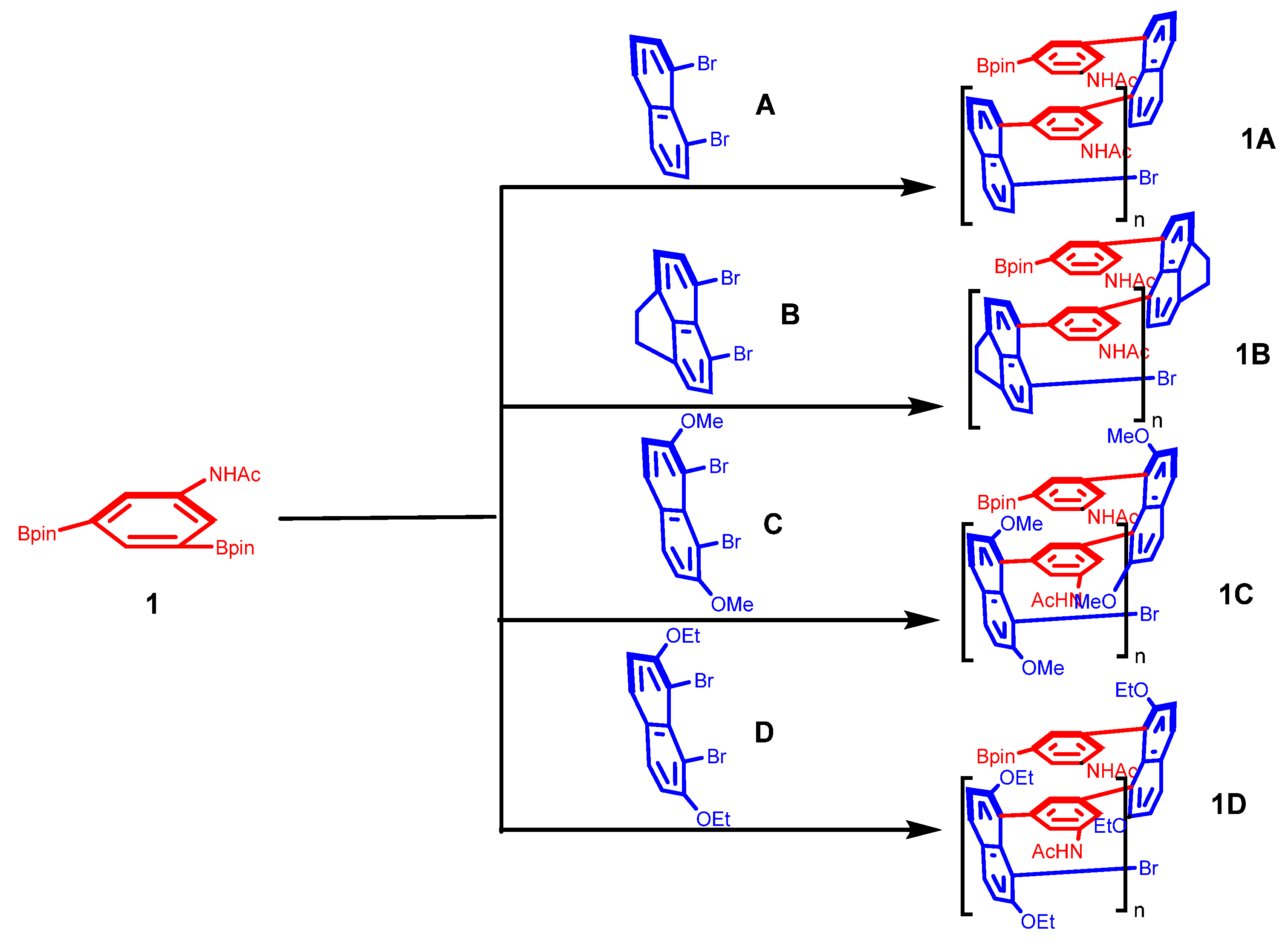
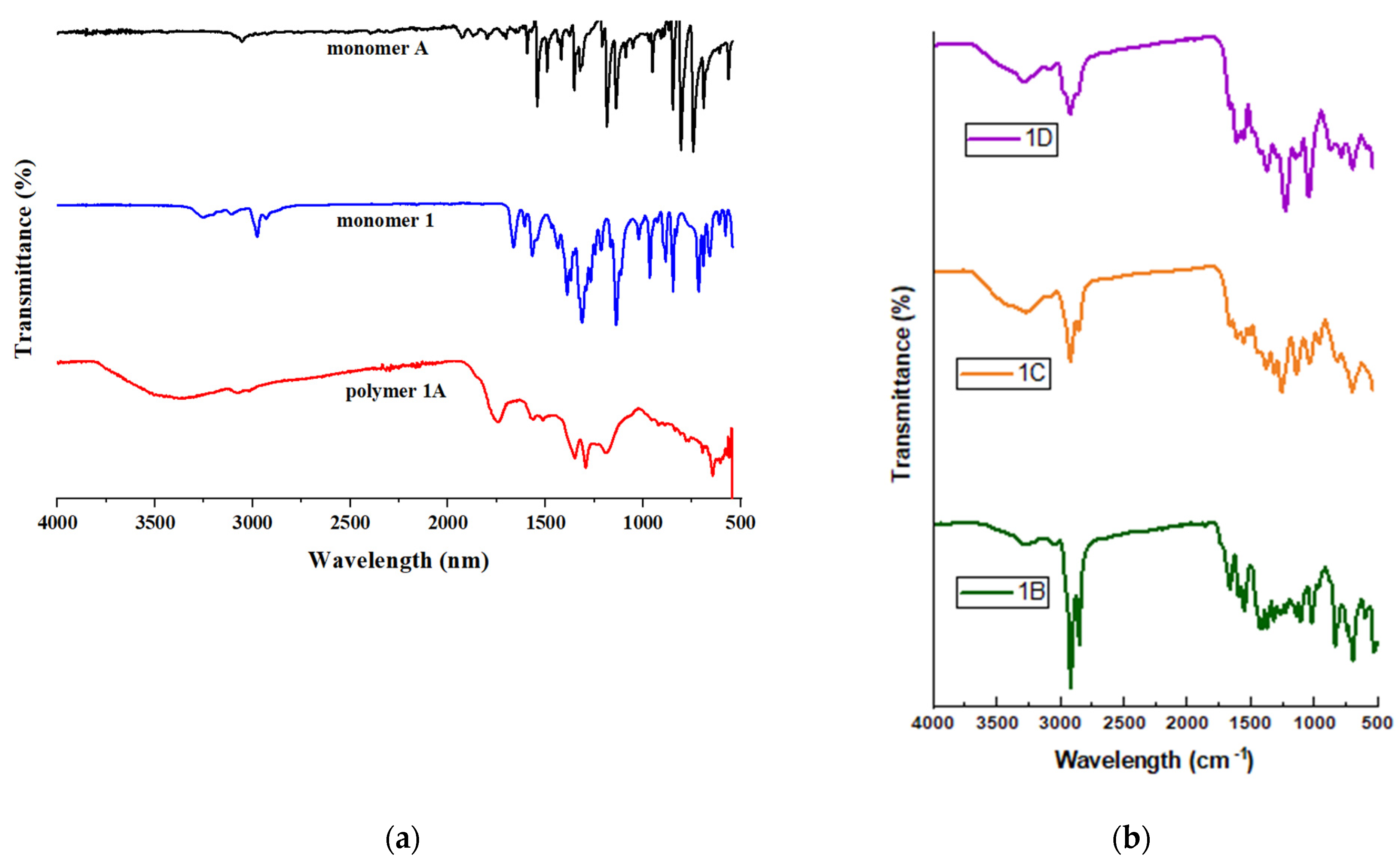
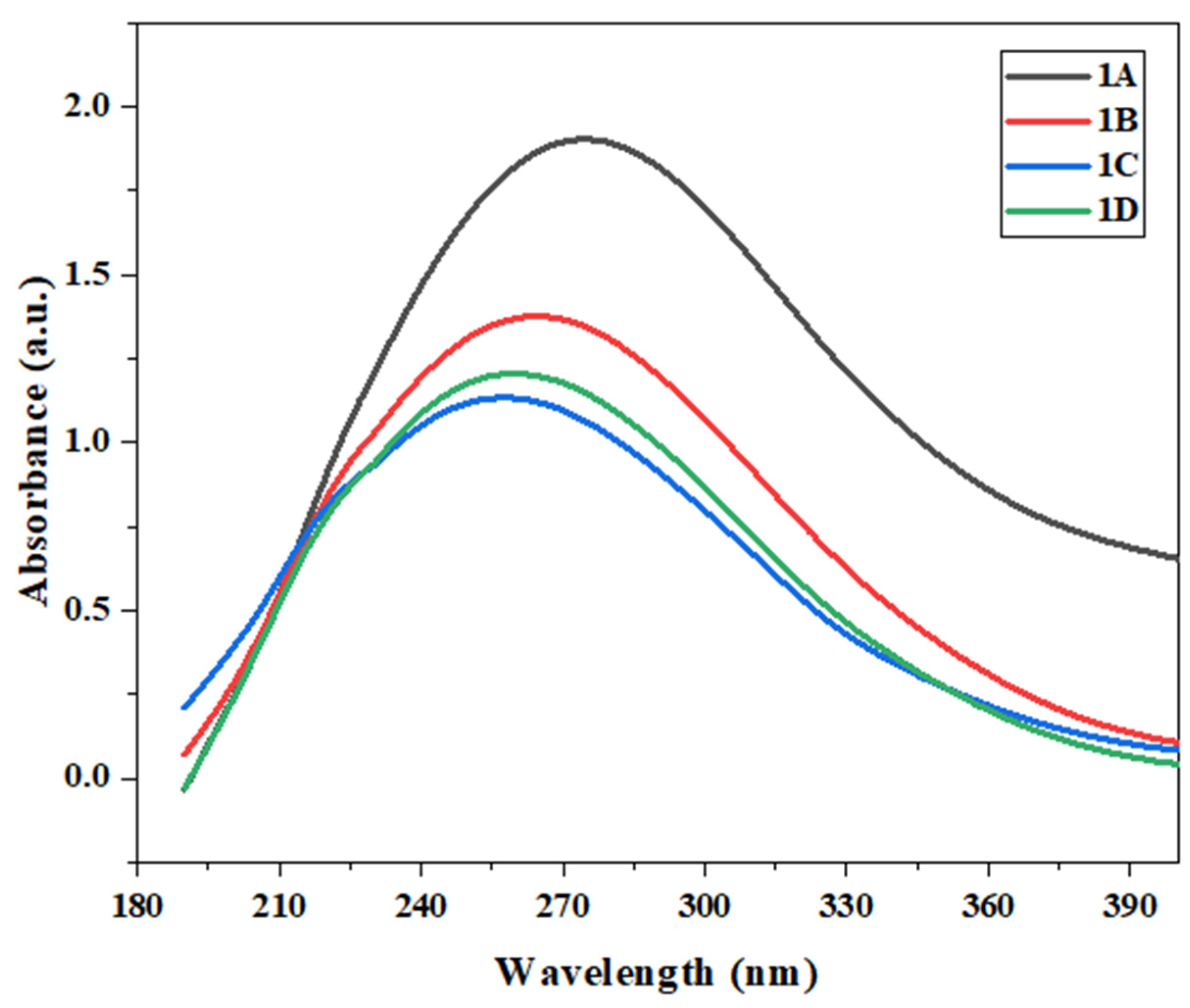
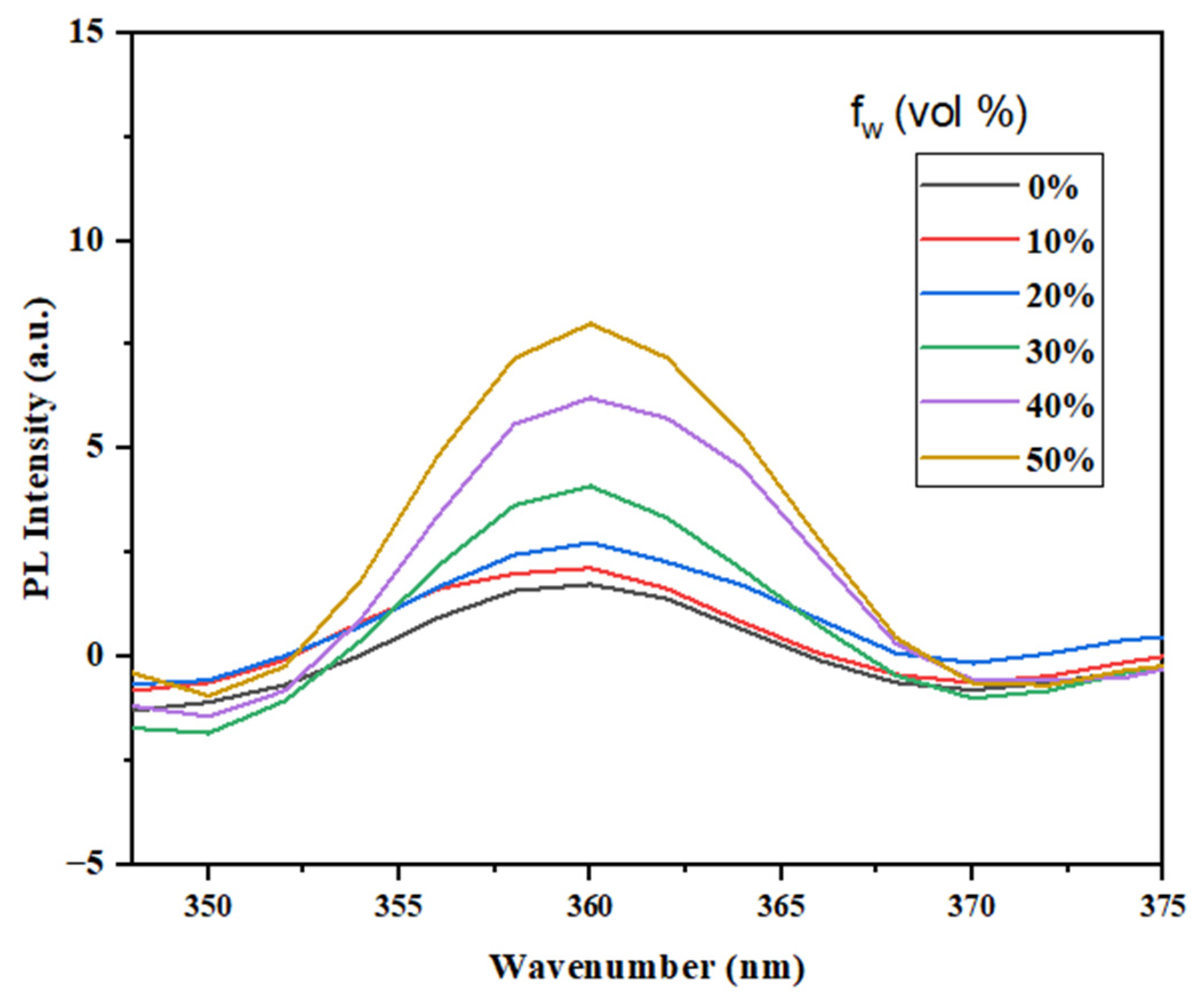
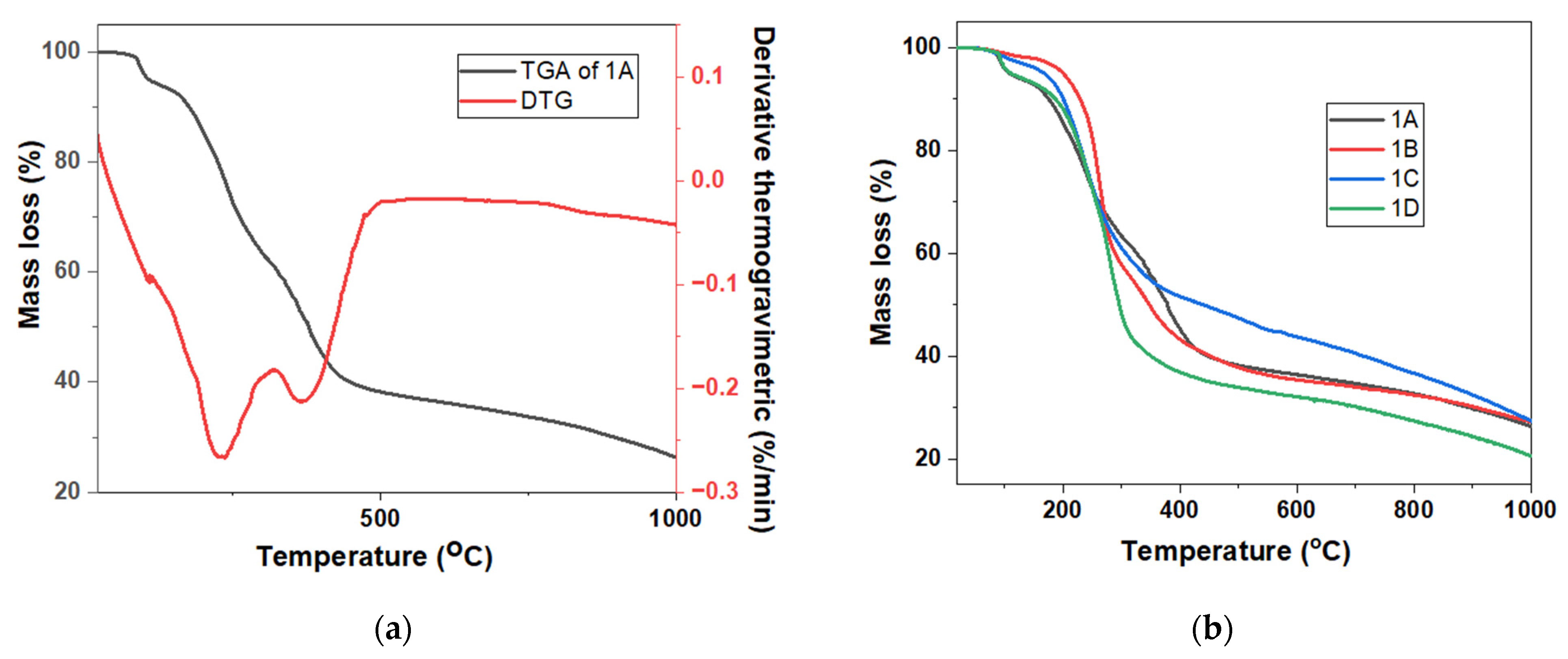

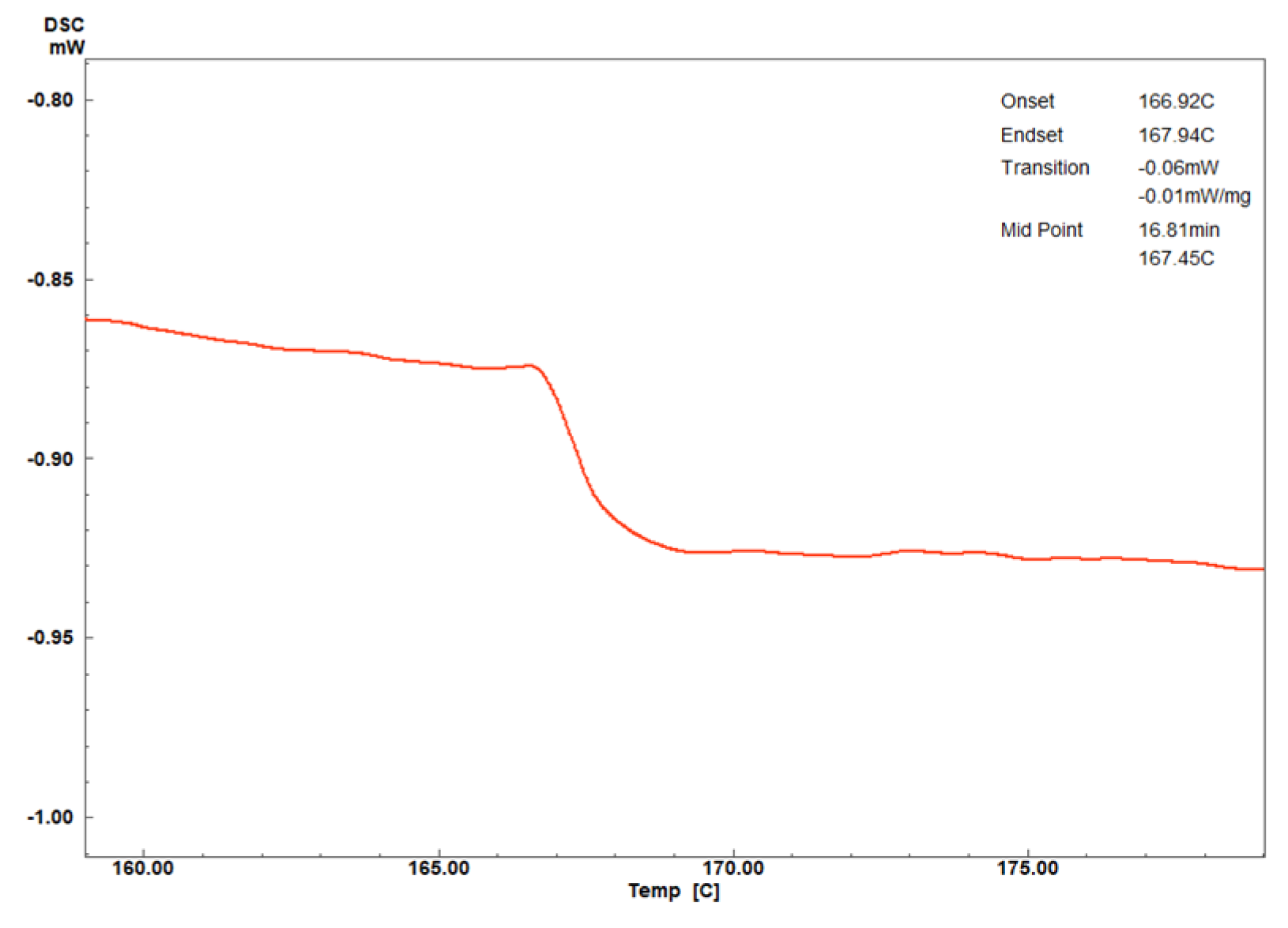
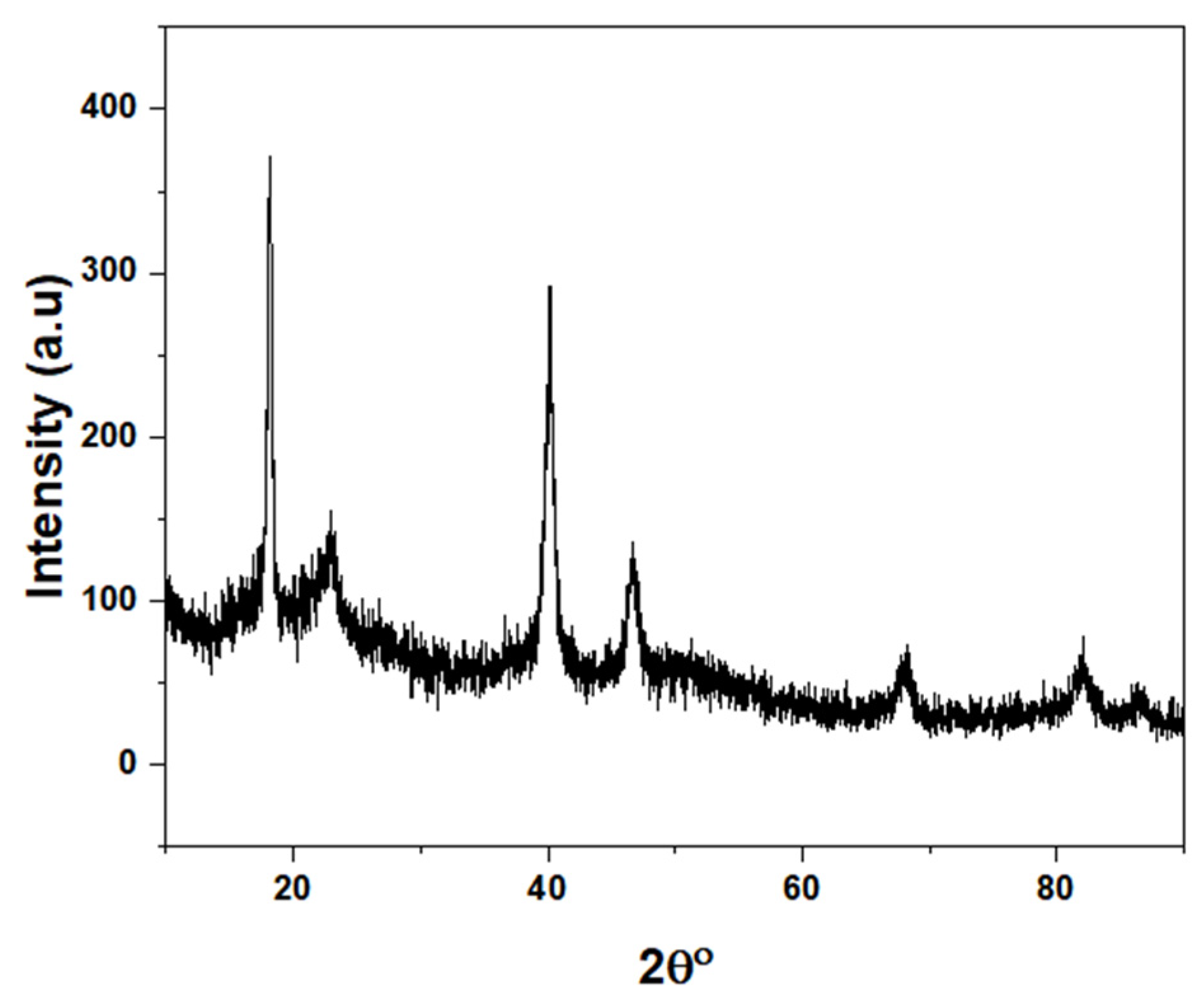
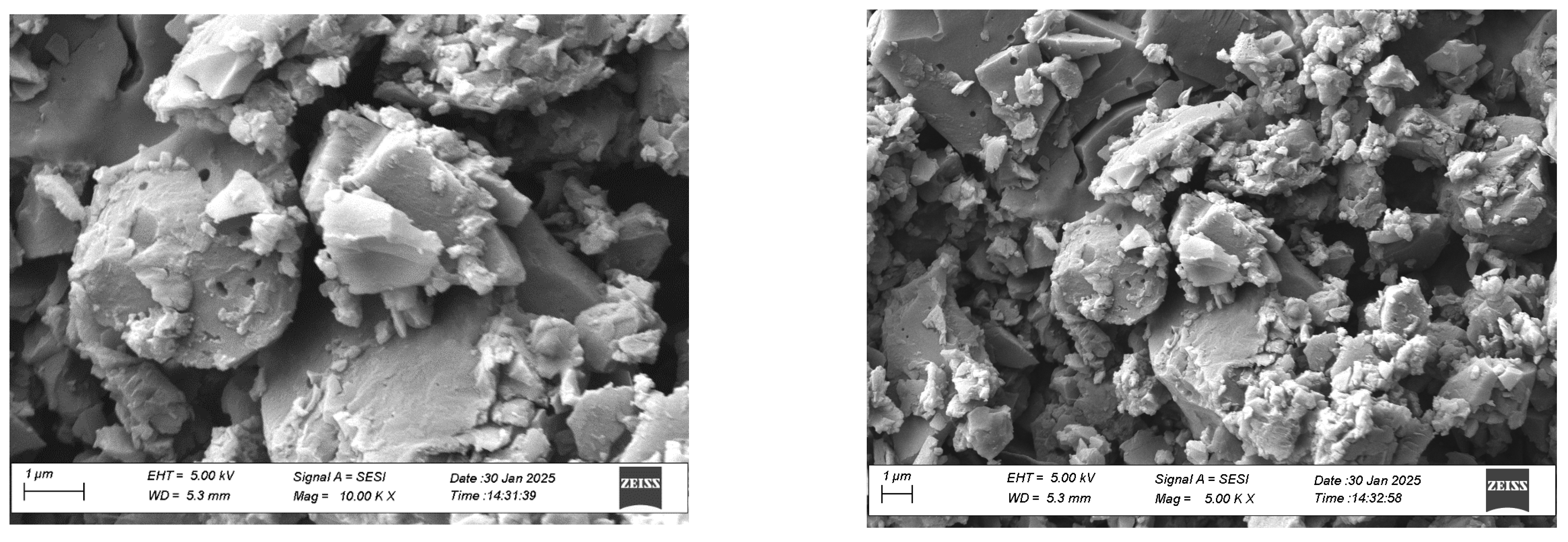
| Poly-Product | Yield a (%) | Mn b | Mw b | PDI c | Theor. Layers d |
|---|---|---|---|---|---|
| 1A | 62 | 68,016 | 82,583 | 1.214 | 320 |
| 1B | 34 | 72,803 | 84,381 | 1.159 | 330 |
| 1C | 70 | 65,917 | 80,674 | 1.224 | 254 |
| 1D | 50 | 69,165 | 85,674 | 1.239 | 248 |
Disclaimer/Publisher’s Note: The statements, opinions and data contained in all publications are solely those of the individual author(s) and contributor(s) and not of MDPI and/or the editor(s). MDPI and/or the editor(s) disclaim responsibility for any injury to people or property resulting from any ideas, methods, instructions or products referred to in the content. |
© 2025 by the authors. Licensee MDPI, Basel, Switzerland. This article is an open access article distributed under the terms and conditions of the Creative Commons Attribution (CC BY) license (https://creativecommons.org/licenses/by/4.0/).
Share and Cite
Phan, M.; Liu, H.; Delgado, L.M.; Faleke, H.O.; Zhang, S.; Cozzolino, A.F.; Pappas, D.; Li, G. The Synthesis and Property Study of NH-Ac-Anchored Multilayer 3D Polymers. Molecules 2025, 30, 1981. https://doi.org/10.3390/molecules30091981
Phan M, Liu H, Delgado LM, Faleke HO, Zhang S, Cozzolino AF, Pappas D, Li G. The Synthesis and Property Study of NH-Ac-Anchored Multilayer 3D Polymers. Molecules. 2025; 30(9):1981. https://doi.org/10.3390/molecules30091981
Chicago/Turabian StylePhan, My, Hao Liu, Lina M. Delgado, Hammed Olawale Faleke, Sai Zhang, Anthony F. Cozzolino, Dimitri Pappas, and Guigen Li. 2025. "The Synthesis and Property Study of NH-Ac-Anchored Multilayer 3D Polymers" Molecules 30, no. 9: 1981. https://doi.org/10.3390/molecules30091981
APA StylePhan, M., Liu, H., Delgado, L. M., Faleke, H. O., Zhang, S., Cozzolino, A. F., Pappas, D., & Li, G. (2025). The Synthesis and Property Study of NH-Ac-Anchored Multilayer 3D Polymers. Molecules, 30(9), 1981. https://doi.org/10.3390/molecules30091981






